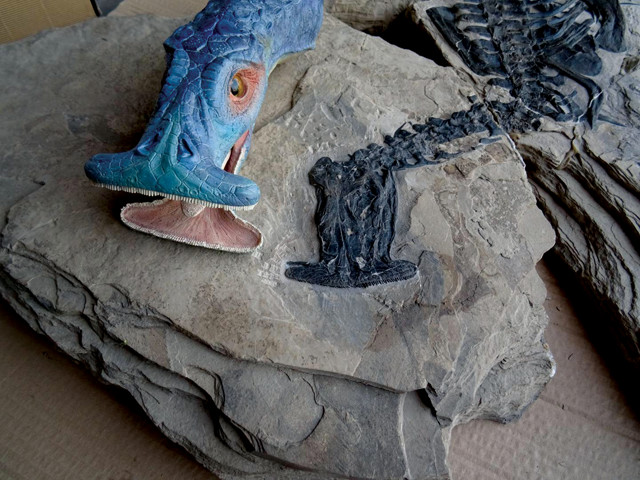
by Mary Caperton Morton Tuesday, September 13, 2016

A model of the head of the hammerhead vegetarian Atopodentatus unicus beside a fossil of the Triassic marine reptile. Credit: ©Nick Fraser.
New fossils found in southern China hint that the earliest herbivorous marine reptiles got off to a bizarre start: Atopodentatus unicus, which lived about 244 million years ago and sported a unique hammerhead-like snout for grazing underwater plants, sheds light on how the earliest marine reptiles began experimenting with herbivory after the Permian mass extinction, which killed off 96 percent of marine organisms about 252 million years ago. This “Great Dying” event left vast holes in the ecology of the Early Triassic, and a diversity of new feeding styles evolved to occupy the open niches.
First described two years ago, Atopodentatus unicus, meaning unique and strange-toothed, was initially thought to have had a downturned snout, similar in shape to a flamingo’s, which it used to hunt prey in muddy seafloor sediments. But the recent discovery of better-preserved and more complete fossils in south-central China, reported in Science Advances by a team led by Li Chun of the Institute of Vertebrate Paleontology and Paleoanthropology in China, suggests a different kind of specialization: The 2- to 3-meter-long reptile was actually a vegetarian, using its wide T-shaped snout and arrangement of chisel-like teeth in the front and needle-like teeth on the sides to scrape algae and other plants from rocky surfaces.
The find represents the earliest evidence of herbivory among marine reptiles. It’s unclear where Atopodentatus fits on the reptile family tree, but it may be related to plesiosaurs, the dominant long-necked predators of the Mesozoic seas.
© 2008-2021. All rights reserved. Any copying, redistribution or retransmission of any of the contents of this service without the expressed written permission of the American Geosciences Institute is expressly prohibited. Click here for all copyright requests.